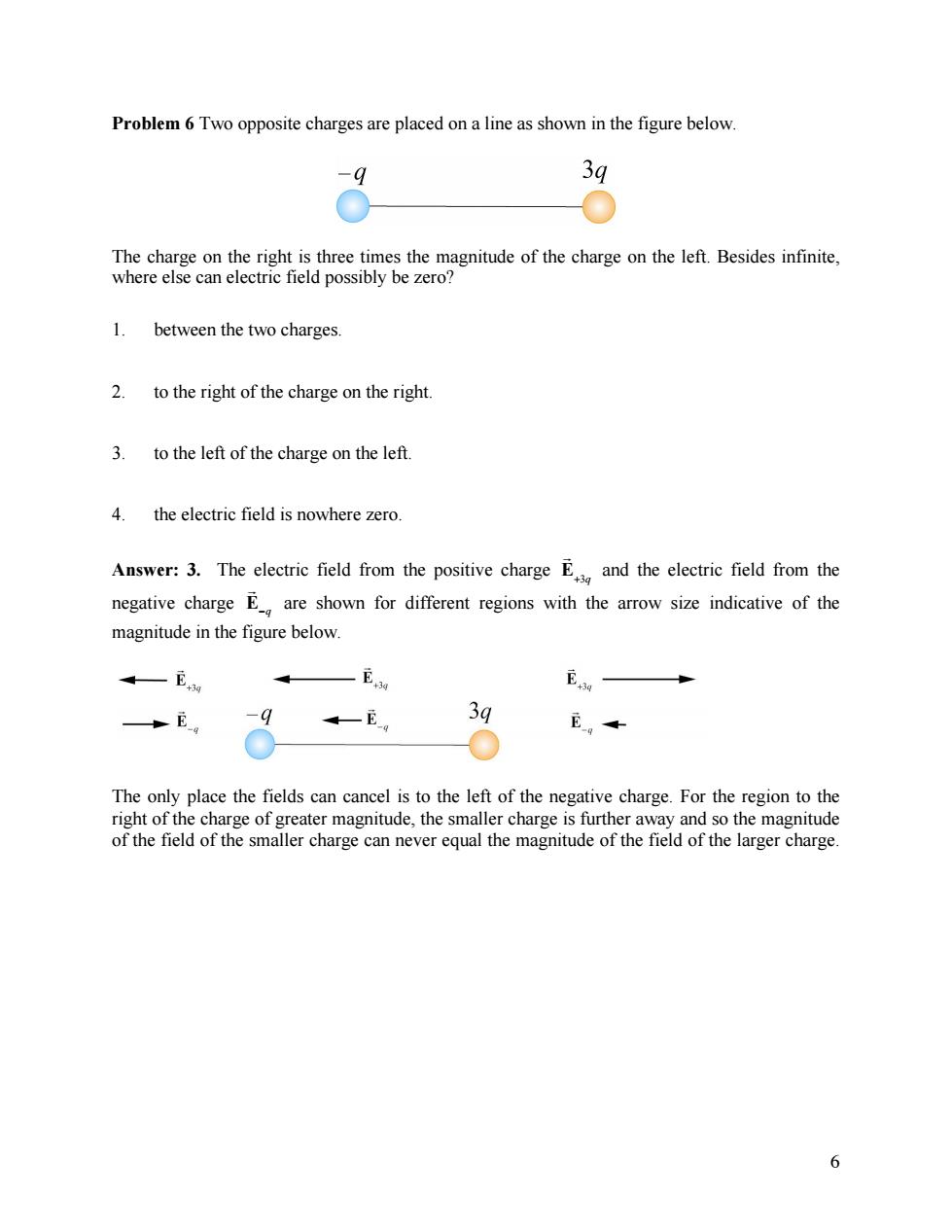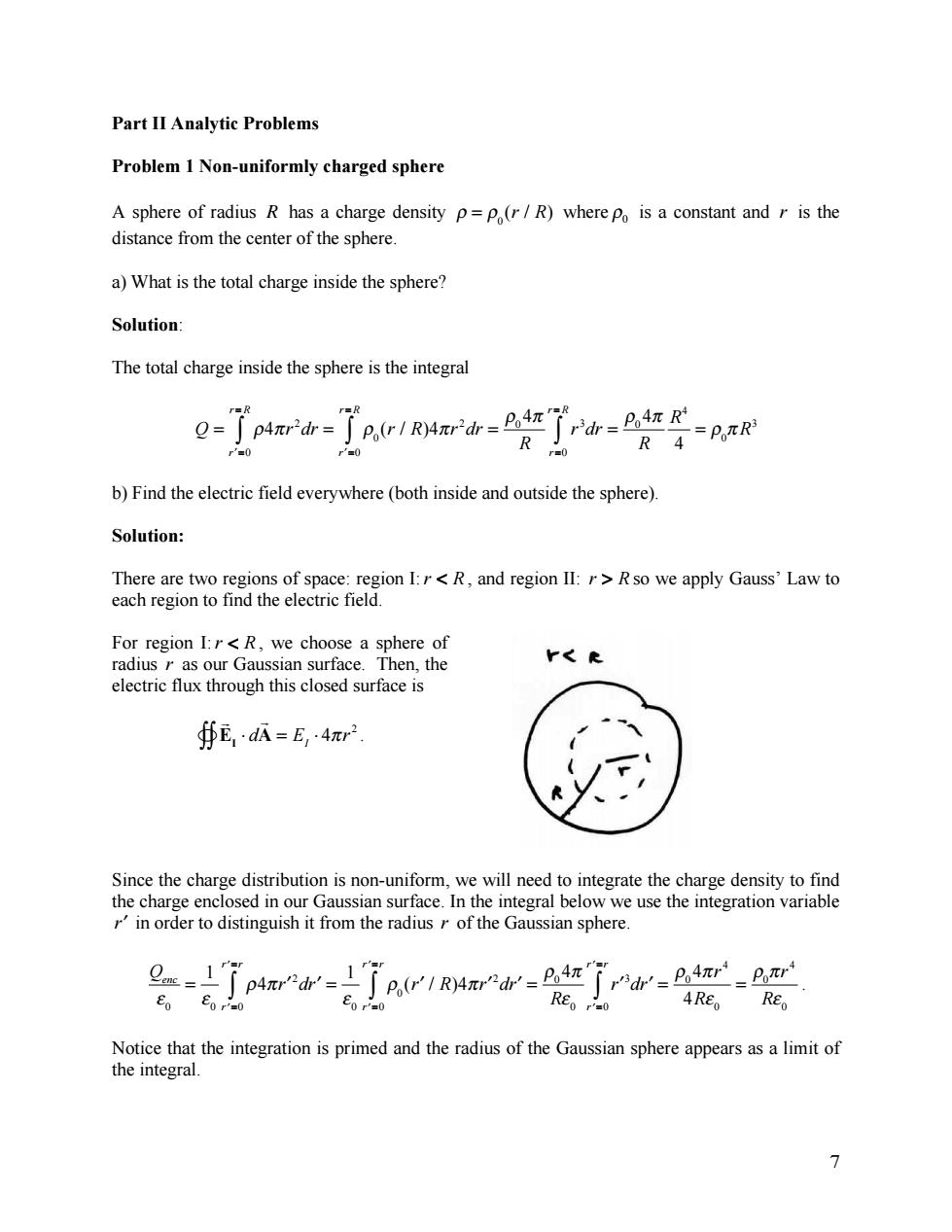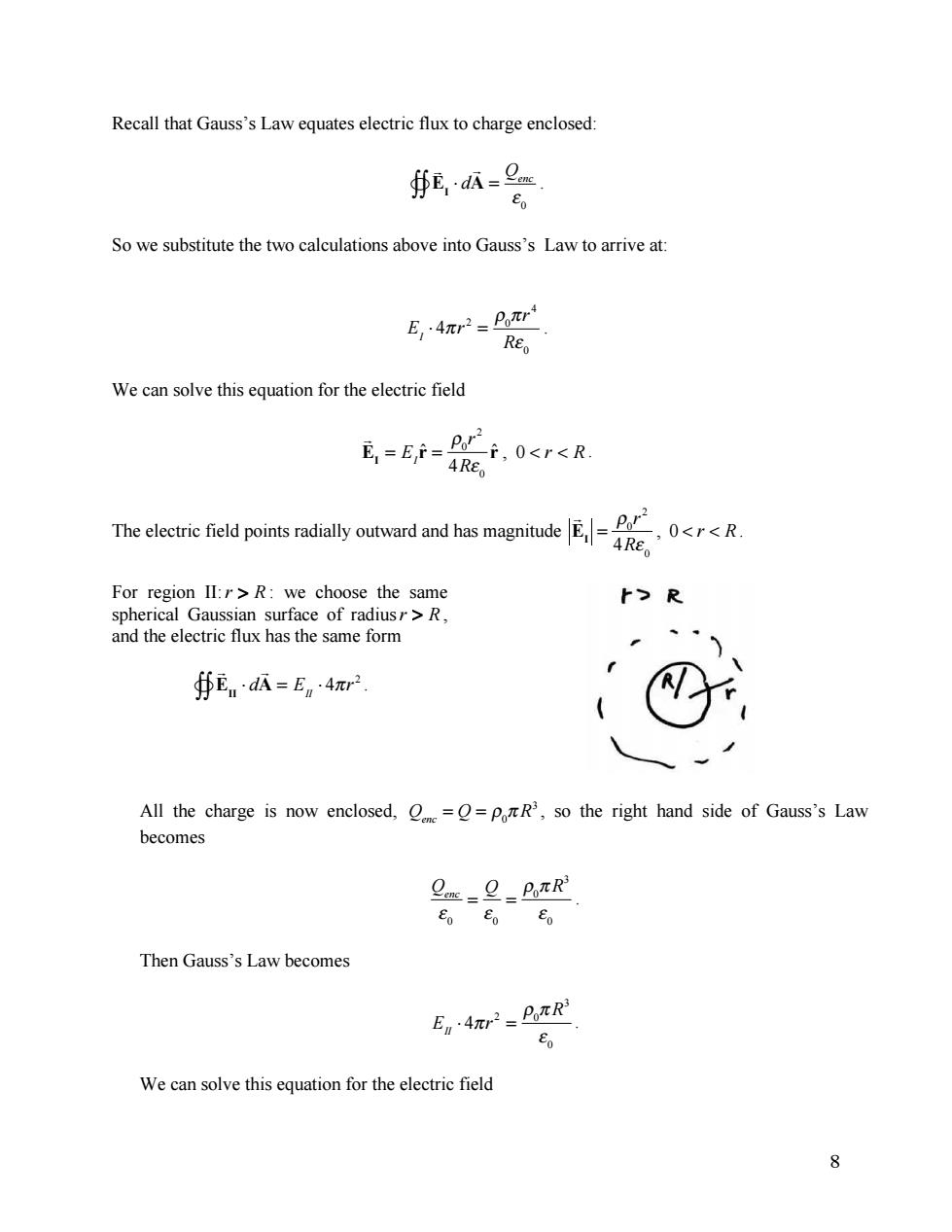
Problem 6 Two opposite charges are placed on a line as shown in the figure below. 34 The charge on the right is three times the magnitude of the charge on the left.Besides infinite, where else can electric field possibly be zero? 1. between the two charges. 2.to the right of the charge on the right. 3.to the left of the charge on the left 4. the electric field is nowhere zero. Answer:3.The electric field from the positive charge E and the electric field from the negative charge E are shown for different regions with the arrow size indicative of the magnitude in the figure below. 30 飞9 +E。 3q E。← The only place the fields can cancel is to the left of the negative charge.For the region to the right of the charge of greater magnitude,the smaller charge is further away and so the magnitude of the field of the smaller charge can never equal the magnitude of the field of the larger charge. 6
6 Problem 6 Two opposite charges are placed on a line as shown in the figure below. The charge on the right is three times the magnitude of the charge on the left. Besides infinite, where else can electric field possibly be zero? 1. between the two charges. 2. to the right of the charge on the right. 3. to the left of the charge on the left. 4. the electric field is nowhere zero. Answer: 3. The electric field from the positive charge ! E+3q and the electric field from the negative charge ! E!q are shown for different regions with the arrow size indicative of the magnitude in the figure below. The only place the fields can cancel is to the left of the negative charge. For the region to the right of the charge of greater magnitude, the smaller charge is further away and so the magnitude of the field of the smaller charge can never equal the magnitude of the field of the larger charge

Part II Analytic Problems Problem 1 Non-uniformly charged sphere A sphere of radius R has a charge density p=p(r/R)where po is a constant and r is the distance from the center of the sphere. a)What is the total charge inside the sphere? Solution: The total charge inside the sphere is the integral Q=∫p4mrt=了p,r1r4r'dh=P4r r=R r=R Jrdh=P4πR4 R R4 =PoTR r'=0 r'=0 r=0 b)Find the electric field everywhere (both inside and outside the sphere). Solution: There are two regions of space:region I:r<R,and region II:r>R so we apply Gauss'Law to each region to find the electric field. For region I:r<R,we choose a sphere of radius r as our Gaussian surface.Then,the F<E electric flux through this closed surface is ∯E,·aA=E,4πr2 Since the charge distribution is non-uniform,we will need to integrate the charge density to find the charge enclosed in our Gaussian surface.In the integral below we use the integration variable r'in order to distinguish it from the radius r of the Gaussian sphere. g=了p4ard=E了,1R4rw=了ra=- r'er Eo e0r'=0 4RE0 REo Notice that the integration is primed and the radius of the Gaussian sphere appears as a limit of the integral. 7
7 Part II Analytic Problems Problem 1 Non-uniformly charged sphere A sphere of radius R has a charge density ! = !0 (r / R) where !0 is a constant and r is the distance from the center of the sphere. a) What is the total charge inside the sphere? Solution: The total charge inside the sphere is the integral Q = !4"r 2 r#=0 r = R $ dr = !0 (r / R)4"r 2 r#=0 r = R $ dr = !0 4" R r 3 r =0 r = R $ dr = !0 4" R R4 4 = !0 " R3 b) Find the electric field everywhere (both inside and outside the sphere). Solution: There are two regions of space: region I:r < R , and region II: r > R so we apply Gauss’ Law to each region to find the electric field. For region I:r < R , we choose a sphere of radius r as our Gaussian surface. Then, the electric flux through this closed surface is ! EI ! d ! """ A = EI ! 4#r 2 . Since the charge distribution is non-uniform, we will need to integrate the charge density to find the charge enclosed in our Gaussian surface. In the integral below we use the integration variable r! in order to distinguish it from the radius r of the Gaussian sphere. Qenc ! 0 = 1 ! 0 "4#r$ 2 r$=0 r$=r % dr$ = 1 ! 0 "0 (r$ / R)4#r$ 2 r$=0 r$=r % dr$ = "0 4# R! 0 r$ 3 r$=0 r$=r % dr$ = "0 4#r 4 4R! 0 = "0 #r 4 R! 0 . Notice that the integration is primed and the radius of the Gaussian sphere appears as a limit of the integral

Recall that Gauss's Law equates electric flux to charge enclosed: ∯E,dA= Eo So we substitute the two calculations above into Gauss's Law to arrive at: E,·4πr2=Pr REo We can solve this equation for the electric field Bi-F 05r<R 4REo The electric field points radially outward and has magnitudeR For region II:r>R:we choose the same r>R spherical Gaussian surface of radiusr>R, and the electric flux has the same form ∯Ed瓜=En4πr2. All the charge is now enclosed,==PoR,so the right hand side of Gauss's Law becomes g-旦_PπR EoEo Eo Then Gauss's Law becomes En·4πr2=PπR We can solve this equation for the electric field 8
8 Recall that Gauss’s Law equates electric flux to charge enclosed: ! EI ! d ! """ A = Qenc # 0 . So we substitute the two calculations above into Gauss’s Law to arrive at: EI ! 4"r 2 = #0 "r 4 R$ 0 . We can solve this equation for the electric field ! EI = EI rˆ = !0 r 2 4R" 0 rˆ , 0 < r < R . The electric field points radially outward and has magnitude ! EI = !0 r 2 4R" 0 , 0 < r < R . For region II:r > R : we choose the same spherical Gaussian surface of radiusr > R , and the electric flux has the same form ! EII ! d ! """ A = EII ! 4#r 2 . All the charge is now enclosed, Qenc = Q = !0 " R3 , so the right hand side of Gauss’s Law becomes Qenc ! 0 = Q ! 0 = "0 # R3 ! 0 . Then Gauss’s Law becomes EII ! 4"r 2 = #0 " R3 $ 0 . We can solve this equation for the electric field